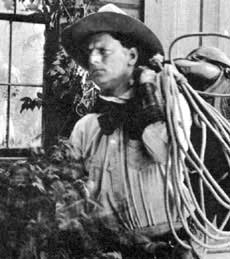March 21, 1880 – January 20, 1971

Movie Cowboy: Bronco Billy was the first silent screen cowboy star and appeared in “The Great Train Robbery”.
Born Max Aronson in Little Rock, Arkansas, “Bronco Billy” was an actor, writer, director, and producer who is best known as the first star of the Western film genre. His mother, Esther Ash Aronson, was from a Russian Jewish family, and his father, Henry Aronson, a traveling salesman, was from a German Jewish family.
At age 18, he moved to New York City where he was a photographer’s model and newspaper vendor before appearing on stage as a vaudeville performer. He later worked with Edwin S. Porter as an actor and sometime script collaborator.
In Porter’s early motion picture The Great Train Robbery (1903), Anderson played three roles. He saw the film for the first time at a vaudeville theater and was overwhelmed by the audience’s reaction to it. It was then that Anderson decided to go into the film industry full bore.
In 1907, he and George K. Spoor founded Essanay Studios (“S and A” stood for Spoor and Anderson), which was one of the predominant early movie studios. He used the stage name Gilbert M. Anderson, and began to write, direct, and act in his own Westerns — over 300 short films made for the studio. He gained the most popularity in a series of 148 Western shorts in which he played the first real movie cowboy hero, “Broncho Billy”.
Anderson also found time to direct a series of comedy Westerns starring Augustus Carney. In 1916, Anderson sold his ownership in Essanay and retired from acting. He returned to New York, bought the Longacre Theatre and produced plays, but without permanent success. He then made a brief comeback as a producer with a series of shorts with Stan Laurel, including his first work with Oliver Hardy in A Lucky Dog (shot in 1919; released 1921). Conflicts with the studio, Metro, led him to retire again after 1920.
He resumed producing movies, as owner of Progressive Pictures, into the 1950s, then retired again. In 1958, he received an Honorary Academy Award as a “motion picture pioneer” for his “contributions to the development of motion pictures as entertainment.”
In his seventies, Anderson came out of retirement for a cameo role in The Bounty Killer (1965).
He died in 1971 at the Motion Picture & Television Country House and Hospital in Woodland Hills, California. He was cremated and his ashes are kept in a vault at the Chapel of the Pines Crematory in Los Angeles.
Anderson was honored posthumously in 1998 with his image on a U.S. postage stamp. In 2002, he was inducted into the Western Performers Hall of Fame at the National Cowboy & Western Heritage Museum in Oklahoma City, Oklahoma. For the past nine years, Niles (now part of Fremont), California, site of the western Essanay Studios, has held an annual “Bronco Billy Silent Film Festival”. He has a star on the Hollywood Walk of Fame.





